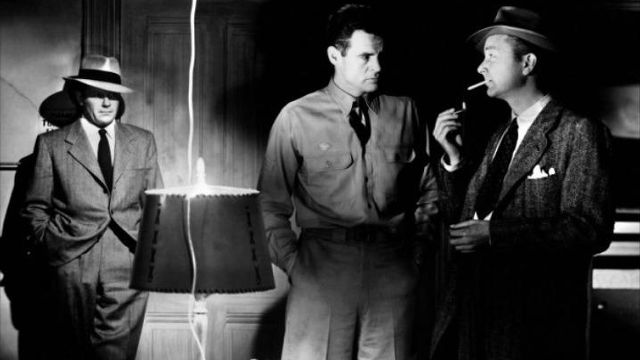Crossfire (1947) 
“Hate Is Like A Loaded Gun!”

Director: Edward Dmytryk
Cast: Robert Young, Robert Mitchum, Robert Ryan
Synopsis: A man is murdered, apparently by one of a group of soldiers just out of the army. But which one? And why?
WARNING – This review contains SPOILERS!
The theme of Richard Brooks’ The Brick Foxhole, the source novel on which Edward Dmytryk’s Noir classic Crossfire is based, was homophobia, but despite the hard-hitting nature of the movie, that topic was still a little too hot for Hollywood to handle thanks to the Production Code that was in force at the time. Nevertheless, that didn’t prevent Dmytryk from inserting some subtle clues pertaining to the sexuality of Samuels (Sam Levene), the man whose murder we witness in a confusing flurry of shadows during the movie’s opening scene. In fact, Crossfire seems to be constantly referring to an undercurrent of forbidden activities.
The story takes place immediately after the war, when enlisted men returning from service continued to wear their uniforms as they strived to assimilate back into society. The Best Years of Our Lives tackled the same subject, but in a much less dark manner. The soldiers in Crossfire are an aimless lot, spending their time in bars, or playing cards in a hostel which is under military control. They come under the scrutiny of Robert Young’s police detective Finlay, in what is possibly the movie’s weakest moment, when the killer, a bullying anti-Semite named Montgomery (Robert Ryan) unaccountably returns to the scene of his crime to find the place crawling with cops. He explains that he’s looking for his buddy, Mitchell (George Cooper) who had left the bar they were in to visit Samuels’ flat with the murder victim and his lady friend.
Montgomery’s account of events immediately sparks a manhunt for Mitchell, a development which alarms his friend and former comrade, Keeley (Robert Mitchum) who instructs his friends to find Mitchell before the police can. When they finally locate him, Mitchell relates a tale that doesn’t tie in with Montgomery’s, and it’s not long before both Finlay and Keeley are coming to the same conclusion about the real identity of the killer. Their suspicions are then confirmed when Floyd (Steve Brodie), the third man in the flat when Samuels was murdered, is found hanging by the neck…
It’s easy to underestimate just how daring Crossfire was for its time. Until it was released, American soldiers had never been depicted in such an unforgiving light. In fact, a couple of years before, when the war was still on-going, its release would probably have been unthinkable. But cinema’s a two-way mirror which both sets trends and reflects them, and no doubt by 1947 the country’s returning war heroes no longer enjoyed their former idealised status. To be fair, it’s only Montgomery who’s an out-and-out villain, and he’s portrayed as an aberration. Ryan relishes the part of one of those menacing types who smile at their victims as a friend moments before they’re beating the living daylights out of them. Even in his calm moments, there’s a calculated coldness around the eyes that belies the rage beneath the surface. In many ways, his performance would have been even more convincing had his prejudice been aimed at homosexuals, but as it is Ryan gives a chillingly convincing performance.
And it’s a performance that pretty much puts everyone else in the shade — or the plentiful shadows. Young gives a decent performance, and just about manages to avoid sounding like he’s giving a prepared speech when he speaks out about prejudice to a crucial witness who is wavering over playing a part in the sting Finlay has prepared for the killer. But his character doesn’t really feel like he belongs in a Noir movie; he’s too laid back — the way he sucks on his pipe you could imagine him sitting at home in a comfy cardigan, stroking the sleeping cat on his lap as he puffs away. At least his character has something to do, which is more than you can say for Robert Mitchum’s Keeley who is almost wholly redundant. But then, he wasn’t quite the finished article back in 1947, and his star was still on the rise, which is why perhaps he’s unusually relegated to the sidelines for this one.
The movie itself is crammed with Noir atmosphere, and features a couple of absolutely first-class supporting characters. The first is Ginny, Gloria Grahame’s world-weary prostitute — thinly disguised here as a dance girl — who takes a shine to young Mitchell when he unexpectedly fails to make the moves on her in the way she expected. She gives him the key to her apartment, and while he waits there for her he receives a visit from Paul Kelly, who’s her husband… No, he’s not… well, maybe he is. Kelly’s The Man is truly an intriguing character straight out of left field who simply belongs in the shadows of Noir. His character is entirely superfluous, and the story wouldn’t be noticeably weakened if he never made an appearance, but what it would lack is the menacing sense of the unknown and the uncertain which he brings to his scenes. Kelly was an interesting character in real life. In 1927 he was imprisoned in Sing Sing for beating to death a man whose wife he would later marry…
(Reviewed 30th July 2013)
httpv://www.youtube.com/watch?v=Qf_tJx9SwMk
